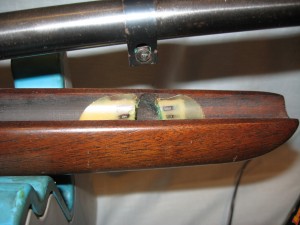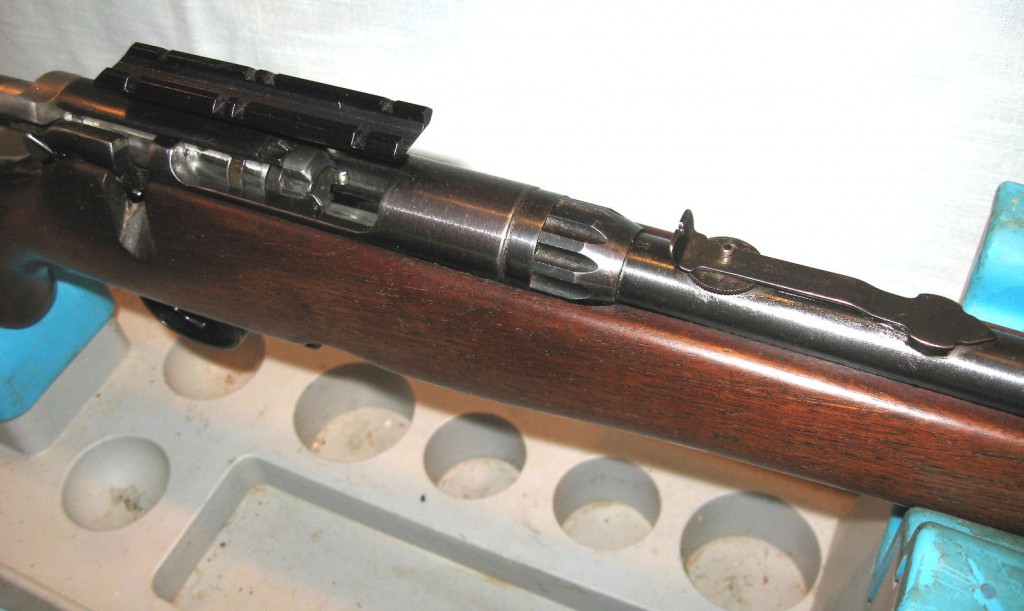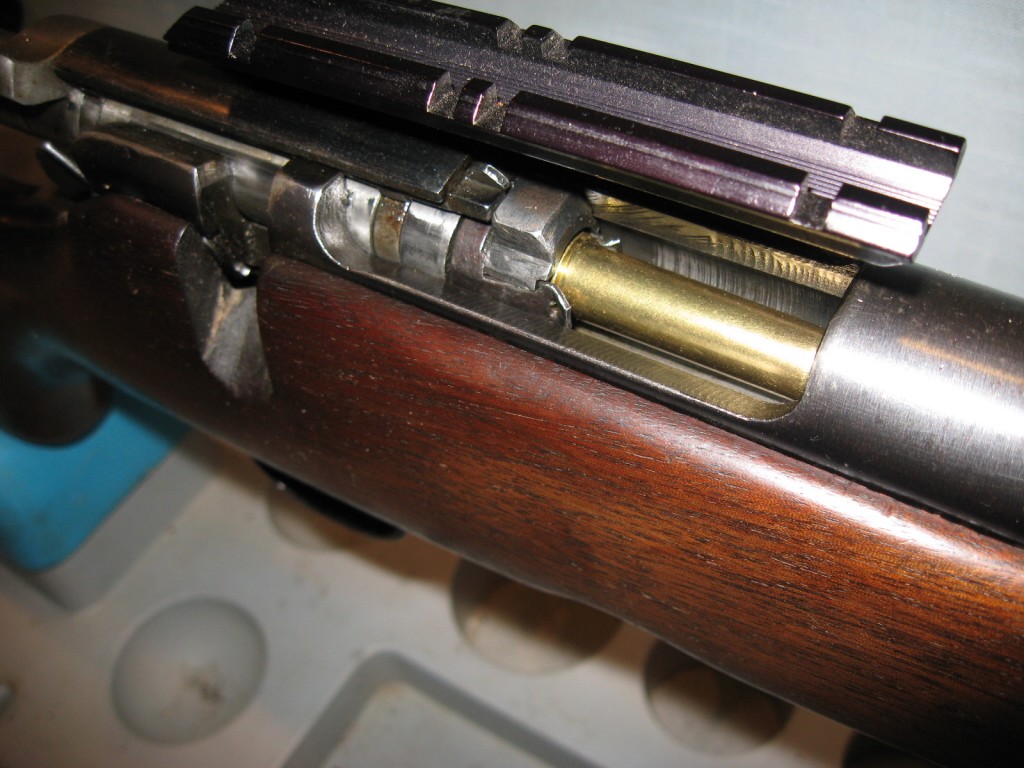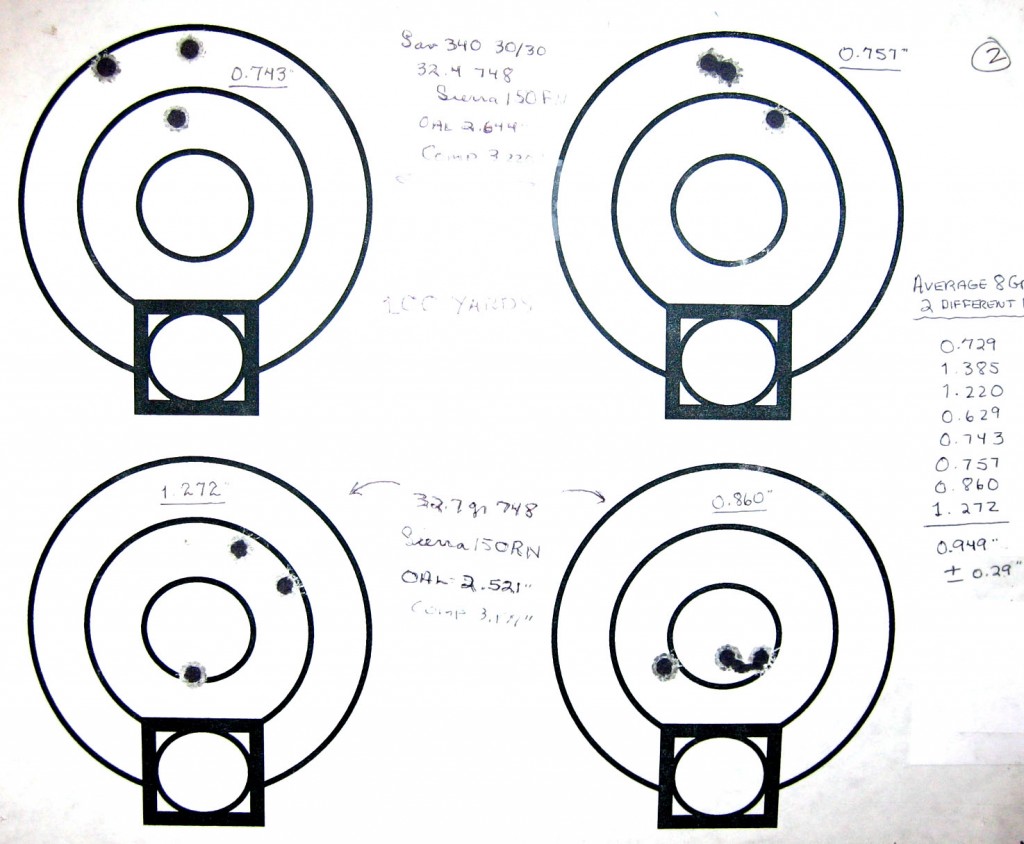This post describes the design and shooting characteristics of a Savage Model 340 bolt-action rifle in caliber .30-30 Winchester.
The plain rifle is an American invention, born of necessity in the days when trappers, explorers, soldiers, and pioneers settled the land and eventually pushed the boundary of the country all of the way to the Pacific shore. The plain rifle thus became a tool of survival in the 18th and 19th centuries. As such, it had to be a tool accessible to everyone who needed it. Indeed, that is why it had to be plain.
Among the many examples of plain rifles that have appeared over the years, there is none plainer than the Savage Model 340. It appeared in 1950, a couple of years after the action was introduced by a rifle bearing the Stevens name. The .30-30 Winchester and .22 Hornet were popular early chamberings, but later on the .222 Remington and .223 Remington were added. A few were made in .225 Winchester. The .30-30, however, was the only medium game chambering ever offered. All of them disappeared in 1985 when the model was discontinued.
We will call it a cheap rifle for the time being. My copy of the 1964 Gun Digest quotes a list price of $63.95. The newer and more respectable Savage 110 was listed at $109, and a layout of about $139 would have been needed to procure the admirable Winchester Model 70 or elegant Remington Model 700 in that year.
Members of the “Get what you pay for” crowd have never spent much time with plain rifles. The late Frank de Haas, in his review of the 340 in his book Bolt Action Rifles,” 3rd Edn. (DBI Books, Inc., Northbrook, Il, 1995) had this to say:
“There is nothing fancy about the M340, and unless it is your very first centerfire rifle, you won’t want to show it to your friends.”
In spite of this, Mr. de Haas, who was a rifle expert of the first rank, gave the 340 a fair evaluation and pronounced it serviceable for deer and varmint hunting.
My Savage 340
It is very far from being my first centerfire rifle, but I am going to show it to my friends anyway because there are some things that need consideration. I found mine at a gun show years ago and bought it because I wanted to shoot some .30-30 in a bolt action rifle. The wood and metal were good and the bore was excellent. I think it dated to the 50’s because it had no tapped holes for scope mounting. Not to get ahead of myself, but it has always performed just fine.
Let’s take a look at Model 340 design features.
Starting at the barrel, there is a barrel band and nut that is inletted into the middle of the
forearm and fastened by a short bolt. This band provides a second point of attachment of the metal, after the action screw that is in the normal position behind the recoil lug. There is no action screw in the tang. This barrel band practice can be criticized because it secures the barrel in a way that could be affected by changes in the wood. I note that on Model 70 Winchesters there was a circular boss on the barrel that was tapped for a bolt that fastened the barrel to the forearm. I have never seen any criticism of this feature in reading about M70s. I glass bedded the inlet in my 340’s stock to provide a secure seat for the banded barrel section.
Moving toward the receiver, we encounter a barrel nut. This is a convenient, innovative method for attaching the barrel to the receiver while setting proper headspace. We have become used to seeing this on more modern Savage rifles in the 110 series. For them, the feature has usually been enthusiastically accepted and some commentators have even stated that it plays a role in the M110’s excellent reputation for accuracy. The Model 340 was the first Savage to have it.
In the photo of the receiver you can see the extractor at the end of the bolt. It is a stamped steel ring that grasps the cartridge head on opposite sides. The photo shows that, as the bolt pushes the cartridge forward, it rises and is captured by the extractor in the recess of the bolt face. Well, what do you know? CONTROLLED ROUND FEEDING! Shades of Mausers and Model 70s. I can safely take my 340 after dangerous game! Wrong! If you double clutch the bolt, it will try to pick up the next round and the action WILL jam. Oh, well, the capture does guide the cartridge well and contributes to reliable feeding.
This does not show in any picture but measurements reveal that the chamber is very long. It has a good 0.30” of free bore, more with some bullets. I do not know if this is a general feature of Model 340s but it sure is present in mine, and it results in velocities being somewhat lower than expected. Another rifle that began life with this free bore feature comes to mind – the Weatherby. The long chamber keeps pressures in check with heavily-stoked ammo. I suppose I could safely use some heavy handloads my 340 if I wanted to. I do not.
Notice that the bolt also has a single locking lug. If any pundit writing about a bolt with a single locking lug ever failed to call the strength of the action into question, I have not seen it. Don’t worry, guys, bolts are not going to blow back into your handsome faces. The 340’s lug is very substantial and safety is added by the bolt handle fitting in its notch in the receiver, which is, by the way, thick.
The bolt picture also reveals a long steel strip that is attached longitudinally to the top of the bolt. When the bolt is operated, the single locking lug lines up with this strip and the aligned strip and lug pass through the split receiver ring as the bolt is drawn to the rear. Thus, the strip acts as a bolt guide. Savage, however, calls it a “gas shield” and I guess it would also serve that function in the event of a case failure. This arrangement brings to mind the Krag-Jorgensen, the U.S. Army’s rifle adopted in 1892. The Krag had a long, strip steel extractor that guided the bolt through the gun’s split receiver ring. Remember that the Krag is always hailed as having the slickest bolt action ever devised.
At the rear of the bolt the cocking piece shows when the action is ready to fire. It also shows that the firing pin travels just a little more than a quarter-inch when the gun is fired. Lock time is thus very fast, a feature always hailed as being desirable and conducive to accuracy. Reviews of the Remington Model 788 have always mentioned this as a factor in the 788’s reputation for excellent accuracy.
shows that the firing pin travels just a little more than a quarter-inch when the gun is fired. Lock time is thus very fast, a feature always hailed as being desirable and conducive to accuracy. Reviews of the Remington Model 788 have always mentioned this as a factor in the 788’s reputation for excellent accuracy.
The stamped steel box magazine does its job, but such cartridge repositories don’t get much respect on the plain rifle scene. It is often mentioned that they can get lost. Sure. You can also lose your car keys or your cell phone while stalking a buck in the brush. You need to take precautions against losing things. And have a backup. In spite of any disadvantages, there must be those who prefer clips, because most lines of upscale bolt actions, like the Remington Model 700, include a detachable magazine model. I note that such offerings have often cost more than their “standard” counterparts. Hmmmmmm….
Well, where are we now? Having looked over the mechanicals you can see that a reasonable description of the Savage Model 340 includes references to the features of other, notable arms: The Winchester Model 70, Remington 700 and 788, other, newer Savages, the Weatherby, the Krag-Jorgensen, and the Mauser. Now, how could a rifle with these associations be a bad deal? Yeah, my tongue is in my cheek with these comments, but only partly.
Shooting the Savage Model 340
My friendly, local gunsmith installed a B-Square side mount for me, and I have generally used a Bushnell 4-12X variable for accuracy shooting at the bench.
Being a deer hunting tool, a Model 340 should be able to maintain 100-yard groups in the two- to three-inch range. My 340 has always done quite a bit better than that at the bench. In a test of 13 different factory loads that I conducted some years ago, The 340’s overall average (four-shot groups) with 150-gr loads was 1.80” (MOA). With 170-gr loads it was 1.99”. Velocities were lower than other rifles gave, a result, I think, of the free bore in the 340’s chamber. The 150s averaged 2228 fps and the 170s averaged 2074 fps.
The 340’s two favorite factory loads were the Federal Classic 150-gr, which gave 1.24,” and the Winchester 170-gr Power point, which gave 1.00.” (Yes!)
Hornady’s innovative 160-gr LEVERevolution load is also well digested by the 340. Testing this ammo gave a velocity of 2161 fps, and two groups averaged 1.25.”
Handloading the .30-30 for the Model 340 is not difficult and often produces loads of superb accuracy. Since any bullet that will work in a .30-06 or a .308 (.308”) will work in the .30-30, there are a blue million choices, enough to keep you busy testing for years. You may, of course, use the common, flat-nose bullets always used in lever action .30-30s, but you are not confined to them. The box magazine of the 340 will be safe with any spitzer bullet that you wish to try. I have tended toward the Sierra products and have used their 150- and 170-grain flat noses along with a lot of their 150-grain round noses. They have all proved capable of very good accuracy. You don’t really need to mess with boattails or with target grade bullets, but I will say that this rifle shoots Sierra’s 155-grain Palma match bullet extremely well. Although the chamber of my 340 is long, I set all bullets deep enough that the loads will work through the magazine. Overall length is 2.64,” as compared to a common, factory load OAL of 2.54.”
Powder choices are also numerous, but stay in the middle range of burning rate. My favorite is Winchester 748. It does not give highest velocities, but it launches most any bullet quite accurately. IMR 3031 is an excellent all-around powder and works really well in the .30-30 if you are after higher velocities. Alliant Reloder 12 is another good choice. My 340 likes to have velocities kept in the range of 2100-2200 fps with 150-grain bullets.
In one series of tests of Sierra’s 150-grain round-nose, nineteen, 3-shot groups at 100 yards averaged 1.53.” Eleven of the 19 groups were under 1.5.” Sierra’s 150-grain flat-nose averaged 1.83” in a similar series of twenty-two, 3-shot groups.
These results reflect very careful reloading and shooting activity which I am not always able to maintain. Yep,it’s true, there have been mediocre days when a 3.5” group might manifest itself. The best results show, however, what the plain rifle is capable of doing, and also that Savage tightened that barrel lock nut down on some pretty darn good barrels.
The Bottom Line
At this point, I estimate that I have put about 1,500 rounds through my Model 340. I doubt that there are many 340 owners that can make such a statement. There have been no problems; nothing on the gun has ever broken. It has maintained its accuracy and has never been temperamental in regard to barrel heating or other shooting conditions. Bolt function has only become smoother and trigger action crisper as time has passed. What more could a plain rifle do? I call it an American classic.
Postscript:
The concept of the plain rifle has survived to the present day. In modern form it makes big game hunting possible for all who want to go afield, so In these days of hard economic times, plain rifles have surged again in the marketplace. Viable examples are offered by Savage, Remington, Mossberg, and Ruger and they appear to be good values for those who can stand plastic stocks and plain finish. All makers boast good accuracy, but what you get will be mainly up to you.






